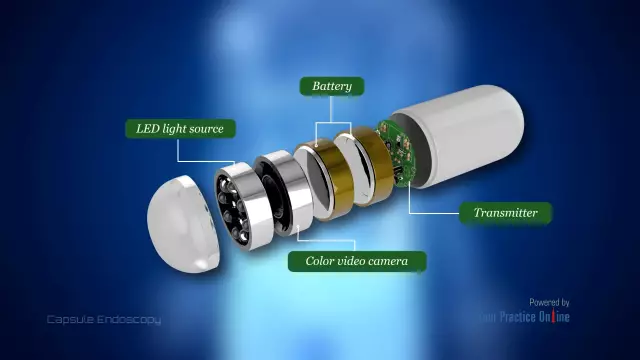- Author Rachel Wainwright [email protected].
- Public 2023-12-15 07:39.
- Last modified 2025-11-02 20:14.
Tulosin
Tulosin: instructions for use and reviews
- 1. Release form and composition
- 2. Pharmacological properties
- 3. Indications for use
- 4. Contraindications
- 5. Method of application and dosage
- 6. Side effects
- 7. Overdose
- 8. Special instructions
- 9. With impaired renal function
- 10. For violations of liver function
- 11. Drug interactions
- 12. Analogs
- 13. Terms and conditions of storage
- 14. Terms of dispensing from pharmacies
- 15. Reviews
- 16. Price in pharmacies
Latin name: Tulosin
ATX code: G04CA02
Active ingredient: tamsulosin (Tamsulosin)
Producer: EGIS CJSC Pharmaceutical Plant (EGIS Pharmaceuticals PLC) (Hungary)
Description and photo updated: 30.11.2018

Tulosin is a drug used for urination disorders caused by benign prostatic hyperplasia (BPH).
Release form and composition
The drug is produced in the form of modified-release capsules: hard gelatinous, self-closing, transparent body and green opaque lid; the contents of the capsules are white pellets, odorless or almost odorless (10 capsules in a blister, 1 or 3 blisters in a cardboard box and instructions for use of Tulosin).
1 capsule contains:
- active substance: tamsulosin hydrochloride - 0.4 mg (corresponds to tamsulosin in the amount of 0.367 mg);
- additional components: microcrystalline cellulose, calcium stearate, copolymer of ethyl acrylate and methacrylic acid (1 ÷ 1) (in the form of a 30% aqueous dispersion solution);
- pellet shell: triethyl citrate, talc, copolymer of ethyl acrylate and methacrylic acid (1 ÷ 1) (in the form of a 30% aqueous dispersion solution), tween 80 (polysorbate 80);
- capsule shell: indigo carmine, gelatin, quinoline yellow; additionally for the cap - titanium dioxide.
Pharmacological properties
Pharmacodynamics
Tamsulosin is an α 1 -adrenergic blocker that competitively and selectively blocks postsynaptic α 1A- adrenergic receptors localized in the smooth muscles of the bladder neck, prostate gland, prostatic urethra, and also α 1D-adrenergic receptors, mainly located in the body of the bladder. Thanks to the action of the active substance, the tone of the smooth muscles of the prostate, the bladder neck and the prostatic part of the urethra decreases, and the function of the detrusor is improved. As a result of these effects, Tulosin provides relief from irritation and obstruction symptoms caused by BPH. The therapeutic effect of the drug is observed, as a rule, 14 days after the start of the course of treatment, however, in some patients, a decrease in the severity of symptoms may be observed after taking the first dose.
The effectiveness of tamsulosin against α 1A -adrenergic receptors is 20 times higher than its effect on α 1B -adrenergic receptors located in the smooth muscles of the vascular walls. Due to such a high selectivity, the active substance does not lead to any clinically significant decrease in systemic blood pressure (BP) in patients with arterial hypertension, as well as in patients with normal initial blood pressure.
Pharmacokinetics
After oral administration, tamsulosin is rapidly and almost completely absorbed from the gastrointestinal tract (GIT). The active substance has almost complete bioavailability (about 100%), its maximum concentration (C max) in plasma is observed 6 hours after a single oral dose. Absorption decreases immediately after a meal. The uniformity of absorption of tamsulosin increases if Tulosin is taken daily at the same time of day after meals. After 5 days of course intake (in an equilibrium state), the values of C max of the active substance in blood plasma are 60-70% higher than those after a single dose.
The connection with plasma proteins reaches 99%, the volume of distribution (Vd) is approximately 0.2 l / kg.
Tamsulosin undergoes the first-pass effect to an extremely small extent and is slowly degraded in the liver, forming pharmacologically active metabolites that retain high selectivity for α 1A -adrenergic receptors. None of the metabolites is more active than the parent substance. In the blood, the active substance is determined predominantly unchanged. On the background of liver failure, there is no need to adjust the dose.
Tamsulosin, like its metabolites, is mainly excreted by the kidneys, with an average of 9% of the dose being excreted unchanged. After a single dose, the half-life (T 1/2) is 10 hours, multiple - 13 hours, the final T 1/2 - 22 hours.
Patients with impaired renal function do not need to adjust the dose of the drug.
Indications for use
Tulosin is recommended for the treatment of functional symptoms of prostate adenoma.
Contraindications
The drug is contraindicated to take with increased hypersensitivity to any of its components.
With caution, Tulosin capsules are prescribed for the following diseases:
- arterial hypotension (including orthostatic);
- severe liver failure;
- chronic renal failure (CRF), with creatinine clearance (CC) below 10 ml / min.
Tulosin, instructions for use: method and dosage
Tulosin capsules are taken orally with plenty of water. They should not be opened, crushed or chewed before use.
Recommended dosage: 1 capsule (0.4 mg) per day, after the first meal.
Side effects
- the most common disorders (1-10%): drowsiness / insomnia, dizziness;
- rare effects (0.1-1%): rhinitis, decreased visual acuity, headache, vomiting, nausea, diarrhea / constipation, asthenia, back pain, retrograde ejaculation, decreased libido;
- extremely rare disorders (0.01-0.1%): hypersensitivity reactions (urticaria, skin rash, pruritus, angioedema), increased heart rate, tachycardia, orthostatic hypotension, fainting, chest pain.
Overdose
There have been no reports of acute overdose of Tulosin. Symptoms of an overdose of tamsulosin may include acute arterial hypotension.
To alleviate this condition, the patient should take a horizontal position in order to normalize the heart rate and restore normal blood pressure. In order to prevent further absorption of tamsulosin, gastric lavage, osmotic laxative or activated carbon can be taken.
If necessary, the patient is prescribed cardiotropic therapy. In addition, kidney control and general supportive care are required. When the symptoms of an overdose cannot be eliminated, solutions that increase the volume of circulating blood or vasoconstrictors should be administered.
Due to the high degree of binding of the drug to plasma proteins, dialysis is ineffective.
special instructions
Tulosin, as well as other α 1 -adrenergic blockers, is recommended to be used with caution in patients with a predisposition to orthostatic hypotension due to a possible decrease in blood pressure, sometimes leading to fainting. If the first signs of orthostatic hypotension appear, such as weakness or dizziness, the patient should be seated or laid down until symptoms relieve.
Before the appointment of Tulosin, the patient should undergo a medical examination to exclude the presence of other concomitant diseases that can cause the same symptoms as BPH. Before the start of the course and regularly during its implementation, a digital rectal examination should be performed, and, if necessary, a prostate specific antigen (PSA) test.
Influence on the ability to drive vehicles and complex mechanisms
Patients driving vehicles and other complex mechanisms should be careful while taking Tulosin.
With impaired renal function
In patients with chronic renal failure (CC less than 10 ml / min), tamsulosin therapy is carried out with caution, since its safety in this group of patients has not been studied.
For violations of liver function
In the presence of severe hepatic impairment, Tulosin should be taken with caution.
Drug interactions
- cimetidine: the plasma concentration of tamsulosin in the blood increases, however, dose adjustment of the latter is not required;
- other α 1 -adrenergic blockers or other drugs that lower blood pressure: a significant increase in the hypotensive effect is possible;
- furosemide: the level of tamsulosin in the blood plasma decreases, the dosage does not need to be changed;
- indirect anticoagulants, diclofenac: the rate of excretion of tamsulosin increases to a small extent;
- amitriptyline, trichloromethiazide, diazepam, glibenclamide, diclofenac, warfarin, simvastatin: the plasma concentration of tamsulosin does not change;
- enalapril, atenolol, theophylline, nifedipine: no interaction with tamsulosin is observed;
- diazepam, propranolol, trichloromethiazide, chlormadinone: there is no change in the concentration of these substances.
Analogs
Tulozin's analogs are: Omnik Okas, Miktosin, Omnik, Glansin, Sonizin, Proflosin, Tamsulozin-Teva, Tamzelin, Fokusin, Tamsulon, etc.
Terms and conditions of storage
Store out of the reach of children at a temperature not exceeding 25 ° C.
The shelf life is 5 years.
Terms of dispensing from pharmacies
Dispensed by prescription.
Reviews about Tulosin
According to most reviews, Tulosin is an effective drug used for urinary disorders caused by BPH. Patients note a significant improvement in well-being after the course of treatment, a fairly good tolerance and a relatively low price of Tulosin. Many also note that the drug is suitable for long-term use.
The disadvantages of the drug include the development of side effects (especially at the beginning of the course), such as a pronounced decrease in blood pressure, drowsiness, headache and dizziness.
Price for Tulosin in pharmacies
The price for Tulozin is 570-620 rubles. per package containing 30 modified release capsules.

Maria Kulkes Medical journalist About the author
Education: First Moscow State Medical University named after I. M. Sechenov, specialty "General Medicine".
Information about the drug is generalized, provided for informational purposes only and does not replace the official instructions. Self-medication is hazardous to health!






